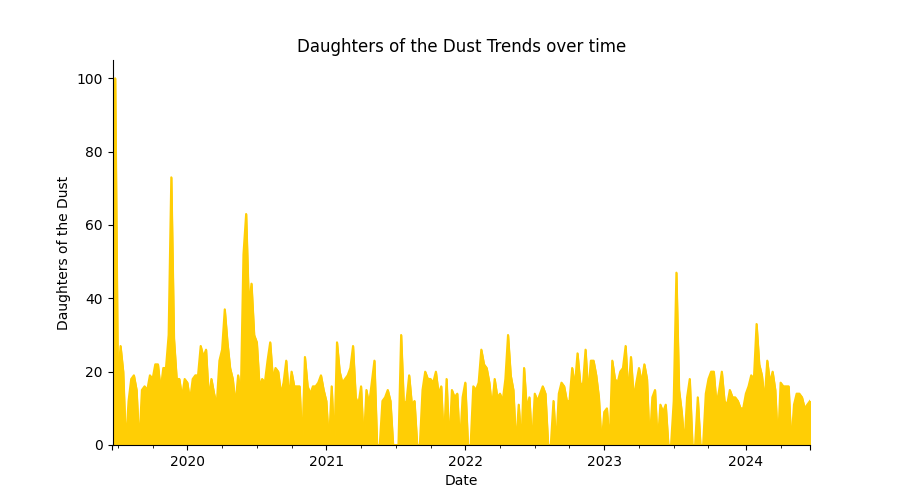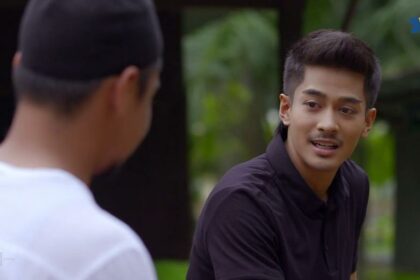
 Story & Synopsis
Story & Synopsis
Set at the turn of the 20th century on the South Carolina Sea Islands, “Daughters of the Dust” delves into the rich tapestry of the Gullah culture, tracing the generational split within the Peazant family. Director Julie Dash and photographer Arthur Jafa craft a visually poetic narrative that intertwines tradition, spirituality, and impending change.
The story revolves around the Peazant family, descendants of West African slaves who have preserved their heritage on the isolated Ibo Landing. As the younger generation contemplates leaving for the industrialized North, matriarch Nana, an 88-year-old mystic, grapples with the fear of losing their roots and traditions. Against the backdrop of impending migration, familial bonds are tested, especially as former prostitute Yellow Mary returns with her female lover, sparking tensions within the family.
Through a nonlinear storytelling approach, “Daughters of the Dust” captures the essence of a community at a crossroads, torn between preserving their cultural legacy and embracing the uncertainties of the future. As the Peazants confront the challenges of change and displacement, Nana’s poignant plea for remembrance echoes the timeless struggle of identity and belonging.
 Cast & Crew
Cast & Crew
Cora Lee Day, Alva Rogers, Barbarao, Trula Hoosier, Adisa Anderson, Kaycee Moore, Bahni Turpin, Cheryl Lynn Bruce, Tommy Redmond Hicks, Cornell Royal
| Actor/Actress | Role |
|---|---|
| Cora Lee Day | Nana Peazant |
| Alva Rogers | Eula Peazant |
| Barbara O. Jones | Yellow Mary |
| Trula Hoosier | Trula |
| Umar Abdurrahamn | Bilal Muhammad |
| Adisa Anderson | Eli Peazant |
| Kaycee Moore | Haagar Peazant |
| Cheryl Lynn Bruce | Viola Peazant |
| Malik Farrakhan | Newlywed Man |
 Reviews and feedback
Reviews and feedback
Welcome to the enchanting world of “Daughters of the Dust,” a cinematic masterpiece that weaves together history, culture, and family in a mesmerizing tapestry of storytelling. Imagine stepping into a time machine that whisks you away to 1902, where the lives of African-American families on a Southern offshore island unfold before your eyes like pages from a vivid novel.
Directed by Julie Dash, this film is not just a movie; it’s an experience. Drawing inspiration from Dash’s own family history, “Daughters of the Dust” delves into themes of heritage, tradition, and the enduring strength of women.
Plot and Themes:
The heart of the story revolves around a family grappling with their past while facing an uncertain future. Alva Rogers shines as Eula Peazant, a woman carrying within her the weight of trauma and resilience. Her unborn child, portrayed by Kay-Lynn Warren, serves as both narrator and spectral presence, guiding us through the complexities of lineage and legacy.
Set against the backdrop of Gullah and African American histories, the film transcends its central narrative to explore broader themes of identity, belonging, and the cyclical nature of time.
Acting and Characters:
The cast delivers performances that are nothing short of captivating. Alva Rogers brings depth and emotion to her portrayal of Eula Peazant, embodying both vulnerability and strength with equal grace. Kay-Lynn Warren’s portrayal of the Unborn Child adds an ethereal quality to the storytelling, blurring the lines between past and present.
Direction and Cinematography:
Julie Dash’s direction is nothing short of visionary. With a keen eye for detail and symbolism, she crafts each frame with care and precision. The cinematography immerses you in the lush landscapes of the Southern offshore island, inviting you to lose yourself in its beauty.
Score and Production Design:
The score complements the visuals perfectly, enhancing every scene with its haunting melodies. The production design transports you seamlessly to 1902, capturing the essence of a bygone era with authenticity and flair.
Special Effects and Editing:
While not relying heavily on special effects, “Daughters of the Dust” uses subtle visual cues to create a sense of magic and mystique. The editing is seamless, allowing each scene to flow effortlessly into the next, drawing you deeper into the narrative.
Pace and Dialog:
The pace of the film is deliberate yet engaging. It allows moments to breathe while maintaining a sense of intrigue throughout. The dialog is poignant and thought-provoking, offering insights into characters’ inner worlds with eloquence.
Binge-Watching Tips:
- Immerse yourself in the rich cultural tapestry depicted in the film.
- Pay attention to subtle details in each scene; they carry deeper meanings.
- Reflect on your own family history while watching to enhance emotional connection.
“Daughters of the Dust” isn’t just a movie; it’s a journey through time and memory that leaves an indelible mark on your soul. With its blend of history, culture, and human experience, this film resonates long after the credits roll.
Ratings: 9/10
In conclusion,
“Daughters of the Dust” is more than a film; it’s a poetic exploration of heritage and resilience that transcends boundaries. Dive into this cinematic gem for an experience that will linger in your thoughts like echoes from another time.
| Pros | Cons |
|---|---|
| Beautiful, slow-paced historical drama | Some viewers may find the pacing slow |
| Deeply personal and inspired by the director’s family history | Violence and cursing present |
| Focuses primarily on the women of the extended Peazant family | Harsh allusions to slavery and hardship |
| Transportive and transformative storytelling | Languid and impressionistic storytelling style |
| Provides a vivid portrait of an era’s spirit | May feel mysterious and dreamlike to some viewers |
Feedback
-
Daughters of the Dust - Wikipedia
Daughters of the Dustis a 1991 independent film written, directed and produced by Julie Dash and is the first feature film directed by an African-American woman to be theatrically released in the United States. Set in 1902, it tells the story of three generations of Gullah (also known as Geechee) women in the Peazant family on Saint Helena Island as they prepare to migrate off the island, out of the Southern United States, and into the North.
Daughters of the Dust Directed by Julie Dash Written by Julie Dash Produced by Lindsay Law Julie DashArthur JafaSteven Jones
-
Daughters of the Dust (1991) - IMDb
Daughters of the Dust directed by Julie Dash is a cultural perspective look into the lives of an African American family left on an island years after being torn from their heritage of Africa for slavery only to have revolted and be left to themselves, stranded on the island off the coast of the Southern eastern coast and the family who live off the island with others who long to find their heritage. The film’s story line is developed in the one day where the family is getting ready to head to a new world on the main land. The internal conflict of the family between relatives who no longer live on the island who have become part of the culture of America post civil war and the family left on the island that live by the old heritage and customs. The family on the island struggle between their history and culture to the change of the times and the need for conformity. This film centers on the generations of the family from the young children who are filled with life then to the adults who are torn between their decisions to leave to finally the center character, the elder grandmother of the family Nana. Nana’s ways and beliefs that have been accepted by the family their entire lives are now the only thing holding the family back from their future off the island. The film focuses largely on the women of the family, displaying the differences of ones who that have lived on the island and then those whom have lived off it. The lines divided between the two are evidently shown throughout the film. The women who lived off the island no longer take to heart their heritage that Nana lives by. They find it to be uncivilized and against the teaching of the bible. There is the scene in which the family after much struggle and torment accept Nana’s decision to stay and her heritage. The scene is of the entire family gathered around the grandmother in which she has a lock of her hair and others placed on a bible asking everyone to believe in the old ways and take her with her by kissing the hair and bible. Finally, the scene acts as importance because one of the outside family members whom diligently preaches and believes in Christianity gives in to Nana’s request.Daughters of the Dust cannot be explained without stating the mise en cinema. From the clothing to the shots of the landscape of the island all resemble the time and place of the film. Not only the background and clothes, but also the character themselves turn this limited distributed film into a believable representation of what people of this time would act and be. The storyline background of the slavery uprising actually having taken place on the island gives it enormous creditability. The shots of the island start the creditability of the film with shots of the women interacting with the water of the ocean and the rivers, the shots of the forest and trees, and finally the most significant may be when the women are preparing the dinner showing how their food is prepared with live seafood and spices gathered from the island. The mise en cinema is creditable because of the clothes as well; from Nana who has only a dress is indigo, which was the main produce to harvest by the slaves on the island to the white Victorian dress of the women from the main land.Dash’s Daughters of the Dust cannot be denied as a cultural perspective that’s originality has touched on the transition to the new culture of African Americans and they past that many have forgotten after the postwar civil war era. Its cultural insight may have been directed to a certain selected target audience, but its look into the heritage of the people cannot be viewed as anything but a respectable insight of the times.
-
Daughters of the Dust movie review (1992) | Roger Ebert
Now streaming on:Julie Dash’s “Daughters of the Dust” is a tone poem of old memories, a family album in which all of the pictures are taken on the same day. It tells the story of a family of African-Americans who have lived for many years on a Southern offshore island, and of how they come together one day in 1902 to celebrate their ancestors before some of them leave for the North. The film is narrated by a child not yet born, and ancestors already dead also seem to be as present as the living.
-
Daughters of the Dust - YouTube
-
Daughters of the Dust | Rotten Tomatoes
Daughters of the Dustaddresses its weighty themes with lovely visuals and a light, poetic touch, offering an original, absorbing look at a largely unexplored corner of American culture.
Daughters of the DustWhere to WatchDaughters of the Dust
Rent Daughters of the Dust on Prime Video, Apple TV, or buy it on Prime Video, Apple TV.
What to KnowCritics ReviewsAudience ReviewsMy RatingCast & Crew
Julie DashDirectorCora Lee DayNana PeazantAlva RogersEula PeazantAdisa AndersonEli PeazantKaycee MooreHaagar PeazantBarbara O.Yellow Mary
 Explanation (Spoiler)
Explanation (Spoiler)
In the 1991 American film “Daughters of the Dust” written and directed by Julie Dash, viewers are transported to the turn of the twentieth century in the Gullah Sea Islands off the coast of Georgia and South Carolina. The story revolves around the Peazant family as they stand on the brink of significant change, with some members preparing to leave the island for a new life on the mainland.
The movie delves into major themes such as the conflict between tradition and progress, the importance of family, the power of memory, and the significance of finding one’s voice. These themes are beautifully woven into the narrative, creating a rich tapestry of emotions and cultural nuances.
One of the standout aspects of the film is the cinematography by Arthur Jafa, which was recognized with an award at the 1991 Sundance Film Festival. The visual storytelling in “Daughters of the Dust” adds another layer of depth to the narrative, capturing the essence of the Gullah culture and the lush landscapes of the Sea Islands.
Julie Dash’s film not only explores the personal stories of the Peazant family but also sheds light on the broader historical and cultural context of the Gullah community. Through the characters of the Peazant family, viewers are invited to reflect on themes of identity, belonging, and the complexities of cultural heritage.
With its unique storytelling approach, rich cultural tapestry, and powerful themes, “Daughters of the Dust” stands as a landmark film that offers a dreamlike and immersive cinematic experience. The film’s inclusion in The National Film Registry in 2004 further solidifies its status as a timeless and important piece of American cinema.
 Parents Guide & Age Rating
Parents Guide & Age Rating
NR
Age Rating:
Daughters of the Dust is rated PG-13 for thematic elements and brief strong language.
Parental Guide:
Daughters of the Dust is a 1991 drama that follows a Sea Island Gullah family in 1902 as they contemplate staying on their island or beginning new lives on the mainland. While the film is critically acclaimed and considered a significant piece of African American cinema, there are some elements parents should be aware of when deciding if it’s appropriate for their children:
- Sex & Nudity: The film contains minimal sexual content, with no explicit scenes or nudity.
- Violence & Gore: There are a few scenes with mild violence, such as characters arguing or in moments of tension, but there is no graphic violence or gore depicted.
- Profanity: The movie includes brief strong language, but it is infrequent and not pervasive throughout the film.
- Thematic Elements: The movie deals with themes of family, heritage, and the decision-making process faced by the characters. It also explores cultural aspects of the Gullah community.
- Language: The film features a challenging dialect that may be difficult for younger viewers to follow, but it adds authenticity to the storytelling.
- Pacing: Daughters of the Dust has a slow pace and a circular story structure, which may not appeal to viewers looking for a fast-paced narrative.
Overall, Daughters of the Dust is recommended for viewers aged 13 and above due to its thematic elements and language content. Parents are encouraged to watch the film first to determine if it aligns with their family’s values and their children’s maturity level.
 Streaming and where to watch
Streaming and where to watch
| streaming service | extra information |
|---|---|
| Amazon Prime Video | Daughters of the Dust is currently available to stream on Amazon Prime Video with Fandor add-on. You can buy or rent Daughters of the Dust for as low as $3.99 to rent or $6.99 to buy on Amazon Prime Video. |
| Criterion Channel | Currently you are able to watch Daughters of the Dust streaming on Criterion Channel. |
| MUBI | Currently you are able to watch Daughters of the Dust streaming on MUBI. |
| Tubi TV | Currently you are able to watch Daughters of the Dust for free with ads on Tubi TV. |
❝ Quotes and Cult
They hug you up quick and soft as the warm sweet wind. Let them old souls come into you, hardy-like. Let them touch you with the hand of time, let them feed your head with wisdom that came from this day in time. Cuz when you leave this island, Eli Peazant, you ain't goin' to no land of milk and honey.
I am the first and the last. I am the honored one and the scorned one. I am the whore and the holy one. I am the wife and the virgin. I am the barren one and many are my daughters. I am the silence that you can not understand. I am the utterance of my name.
I love you 'cause you're mine. You're the fruit of an ancient tree.
The ancestors and the womb, they're one, they're the same.
What're we supposed to remember, Nana? How, at one time, we were able to protect those we loved? How, in Africa world, we were kings and queens and built great big cities?
Eli I'm trying to teach you how to touch your own spirit. I'm fighting for my life, Eli, and I'm fighting for yours.
 Daughters of the Dust Reddit Talks
Daughters of the Dust Reddit Talks
Daughters of the Dust: A Film Inspired by African-American History and Culture
“Daughters of the Dust,” a groundbreaking film released in 1991, stands as a significant cinematic achievement, not only for its artistic merit but also for its cultural relevance. Directed by Julie Dash, the film delves into the lives of the Peazant family, exploring themes of identity, tradition, and the complexities of the African-American experience.
Fictional Story with Deeply Personal Roots
While not a direct retelling of any specific true story, “Daughters of the Dust” draws inspiration from Dash’s own family history. The film captures the essence of the great migration, when many African Americans left the South for the North following emancipation. Through the Peazant family’s experiences, the film sheds light on the challenges and choices faced by African Americans during this transformative period.
Exploring Identity and the Meaning of Home
The Peazant family’s decision to leave their ancestral island for a new life on the mainland forms the central conflict of the film. As they grapple with this choice, they confront questions of identity, belonging, and the preservation of their cultural heritage. The film delves into the complexities of family relationships, the tension between tradition and modernity, and the search for a sense of place.
Visual Poetry and Cultural Significance
“Daughters of the Dust” is renowned for its stunning cinematography, which captures the beauty and richness of the Gullah culture. The film’s dreamlike atmosphere, evocative imagery, and haunting score create a mesmerizing cinematic experience. Its significance lies in its groundbreaking representation of African-American culture and history, offering a unique and powerful perspective on the black experience.
Critical Reception and Legacy
Upon its release, “Daughters of the Dust” received critical acclaim for its originality, artistry, and cultural importance. It became the first feature film directed by an African-American woman to receive a general theatrical release in the United States. The film has since been recognized as a classic of American cinema and continues to inspire and resonate with audiences today.
Despite its critical success, the film has also garnered mixed reactions. Some viewers have found it challenging to understand due to its non-linear narrative and use of Gullah dialect. However, the film’s supporters argue that its unique storytelling approach and cultural specificity contribute to its overall impact and significance.
A Complex and Nuanced Exploration of African-American Identity
“Daughters of the Dust” is a complex and multifaceted film that offers a profound exploration of African-American identity, history, and culture. Through its rich characters, stunning visuals, and evocative storytelling, the film invites viewers to engage with the complexities of the black experience and gain a deeper understanding of its historical and contemporary significance.
Top discussions
- https://www.reddit.com/r/TrueFilm/comments/13ni7gp/i_really_didnt_enjoy_daughters_of_the_dust/
- https://www.reddit.com/r/blackladies/comments/6hvo2l/daughters_of_the_dust_discussion/
- https://www.reddit.com/r/blackladies/comments/6eihcp/julie_dashs_daughters_of_the_dust_heads_to/
- https://www.reddit.com/r/TrueFilm/comments/8u99wd/movies_like_daughters_of_the_dust_1991_and_red/
- https://www.reddit.com/r/blackladies/comments/cyt4ym/in_1991_julie_dash_premiered_her_first_feature/
 Frequently Asked Questions
Frequently Asked Questions
Is Daughters of the Dust based on a true story?
Daughters of the Dust is fictional, but inspired by director Julie Dash’s own family history, adding a deeply personal touch to the film.
What was the movie Daughters of the Dust about?
Daughters of the Dust follows characters like Eula Peazant, played by Alva Rogers, who is pregnant after being raped by a white man. The film delves into the Gullah and African American pasts and futures beyond the central story.
What is the plot of Daughters of the Dust?
Set in 1902 among the Gullah community in South Carolina, the movie explores a generational split within a family as they navigate tradition and modernity.
What is the purpose of Daughters of the Dust?
Daughters of the Dust serves as a cinematic exploration of African diasporic storytelling, showcasing visually arresting imagery and a rich character scope that delves into the fractured depth of Black souls.
Where was Daughters of the Dust filmed?
Director of photography Arthur Jafa filmed on location at St. Helena Island and Hunting Island off the South Carolina coast, capturing the essence of the story.
Who is Trula in Daughters of the Dust?
Trula, played by Trula Hoosier, is Yellow Mary’s traveling companion and girlfriend in the movie, adding depth to the character dynamics.
 Recommended Movie and TV Show
Recommended Movie and TV Show
Similar movies to Daughters of the Dust:
- Nothing But a Man: A powerful drama exploring African-American life in the 1960s.
- One Sings, the Other Doesn’t: A tale of female friendship and empowerment set against the backdrop of the women’s movement.
- The Watermelon Woman: A unique film exploring race, sexuality, and identity.
- Roots: A groundbreaking miniseries chronicling the history of an African American family.
- A Raisin in the Sun: A classic drama addressing race, family, and dreams.
- Whale Rider: A touching story of a young Maori girl challenging tradition.
- ¡Yo soy Boricua, pa’ que tú lo sepas!: A documentary celebrating Puerto Rican heritage and culture.
- The Birth of a Nation: A historical drama depicting the Nat Turner slave rebellion.
- The Long Walk Home: A poignant film about the Civil Rights Movement in the 1950s.
- The Secret Life of Bees: A heartwarming story of female empowerment and resilience.
- Shadow Magic: A tale of cultural exchange and the magic of early cinema.
- Mandingo: A controversial film exploring themes of race and slavery.
- Glory: A powerful historical drama about the first all-black volunteer company in the Civil War.
- Borat Subsequent Moviefilm: A satirical comedy following the misadventures of Borat.
Wallpapers & Media
 Audience Trends
Audience Trends







 Discover more titles
Discover more titles


 Contribute to this page
Contribute to this page